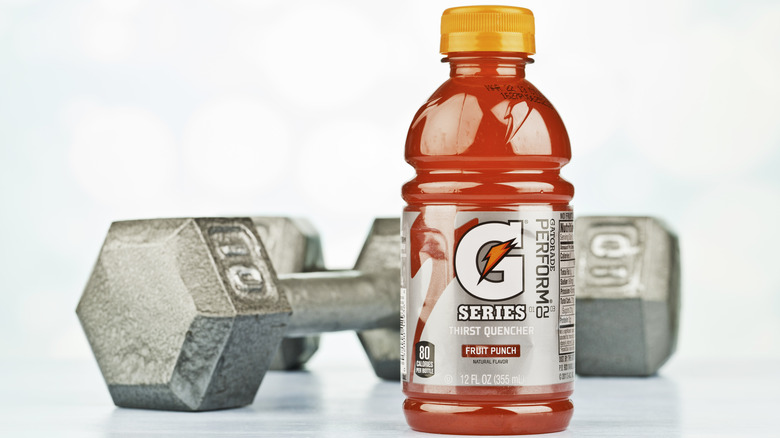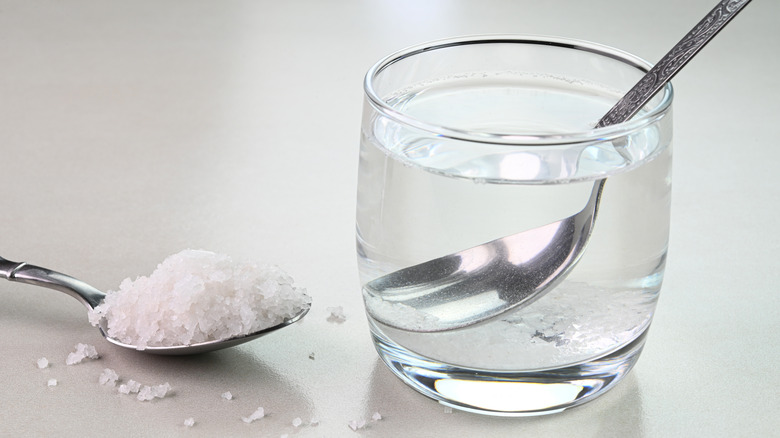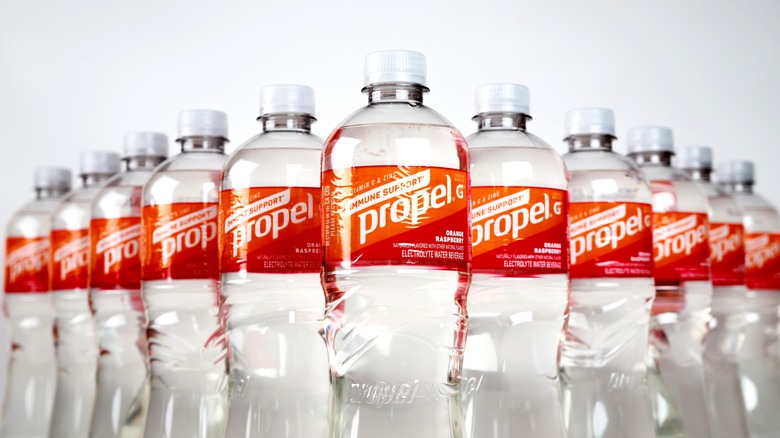Gatorade Vs Propel: The Nutritional Difference Between The Two Drinks
Whether you've been exercising for the last hour, pushing yourself to new heights, or you just finished mowing the yard in the blistering heat, your body needs to replenish spent nutrients. A quick and easy way to do that is to chug a sports drink. You'll likely reach for a Gatorade first; after all, the popular line accounted for a staggering 63.5% of sports drink sales in the U.S. in 2023. And if not a Gatorade, perhaps a Propel, an alternative to Gatorade made by the same company.
Both drinks have the same goal: rehydrate and replenish. But they approach that aim from two vastly different angles. Gatorade, since its inception in 1965, has combined salt with heavy amounts of sugar to help revive exhausted athletes and give them extra energy to finish the game. Propel, launched in 2002, seeks to provide rehydration for people who don't want to consume so much sugar and want healthier ingredients like vitamins in their sports drinks.
Before diving into greater detail on Gatorade and Propel's nutritional similarities and differences, a quick housekeeping note. Gatorade and Propel come in many forms and flavors with different nutritional compositions. Gatorade Zero, for example, doesn't have the sugar of the standard formula. To keep this article focused, it will only consider the baseline formulas of the two drinks in single-serving 20-ounce bottles.
Gatorade and Propel: nutritional similarities
The nutritional similarity of Gatorade and Propel is their electrolytes. In fact, Propel bottles even advertise that they have Gatorade electrolytes. However, there are many different kinds, including, but not limited to, calcium, magnesium and phosphate. Generally, these electrolytes work to aid your body's nerves, muscles and brain function. Gatorade and Propel both use 270 mg of sodium, plus some potassium, either 80mg for Gatorade or 70mg for Propel.
The sodium is most important. It helps the body's cells keep their fluids at the proper levels and aids in absorbing the nutrients that are in the two drinks. Potassium works in conjunction with the sodium since potassium enters a cell when sodium leaves it (and the inverse is true, too).
They also share some minor similarities with minimal impact. Both have citric acid as a preservative, for example, and both use sweeteners (dextrose for Gatorade and sucralose for Propel) to improve flavor.
Gatorade and Propel: nutritional differences
With both drinks providing the same electrolytes and hydration, the unique additives push them towards their intended audience. For Gatorade, that's 36 grams of carbohydrates, the body's main energy source. 34 of those grams are from sugar, an eye-opening 69% of your daily value. For perspective, a 20-ounce bottle of Coke has 65 grams or 130% of your daily value.
These sugar carbs exist in Gatorade because it's intended for exhausted athletes. Studies involving children show sports drinks like Gatorade are best consumed to replenish the electrolytes and energy you lose after at least one hour of intense activity in extreme conditions. Otherwise, the extra sugars, and 140 calories that come with it, don't get burned away. When used as an everyday drink, Gatorade is more like a non-carbonated soda than a health-replenishing nectar.
But what if you've been exercising for 30 minutes in moderate conditions, and you're done for the day? Enter Propel. By keeping the same electrolytes as Gatorade, but dropping all sugar, it becomes a zero-calorie way to replenish what you've lost with more flavor than plain water. Propel also benefits you from its extra vitamins: B3, B5, B6 (all of which help convert certain nutrients into energy and improve digestion, among other benefits), vitamin C (an antioxidant), and E (another antioxidant, plus other benefits like helping to maintain good vision and healthy blood).


